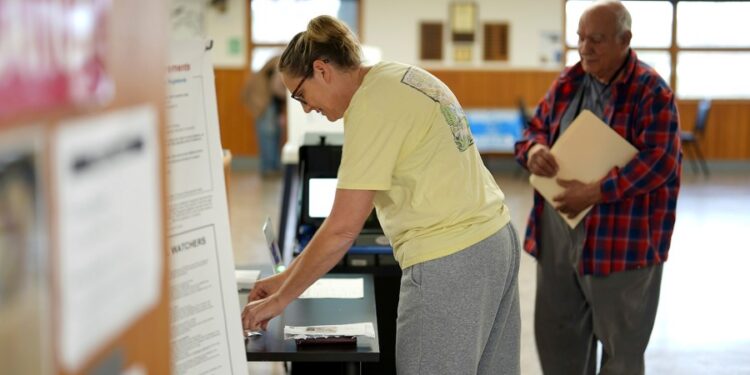
Democrats are already seeing some small victories in under-the-radar races in the beginning of 2025, with the party hoping they can maintain that energy heading into November as they look to flip the Virginia governor’s mansion and hold off GOP opponents in other elections.
The party flipped a state Senate seat in Iowa last month, while a Democrat recently ousted a conservative mayor in Norman, Okla. Meanwhile, in New York, Democrat Ken Jenkins won a county executive seat, improving on the party’s November performance there. And last month, the Democrats retained their control over a Loudoun County, Va.-area state House and Senate seats after the party underperformed in November.
The victories continue a trend the party has seen for multiple cycles in which it has won big in off-year elections where President Trump wasn’t on the ballot. But some in the party argue more needs to be done in order to turn out voters ahead of the first major high-stakes races following Trump’s victory in November.
“I would describe most of these races as simply Democrats holding serve, with the big exception of an Iowa state Senate race where Democrats flipped a district that Trump had won by roughly 20 points,” said Kyle Kondik, managing editor at Sabato’s Crystal Ball at the University of Virginia Center for Politics.
In the Westchester County executive race, Democrat Ken Jenkins handily defeated his Republican opponent 64 percent to 36 percent after President Trump improved his standing in the county from 2020 to 2024.
Trump himself even got involved in the race, urging Republicans to turnout in a post on Truth Social earlier this week.
“On Tuesday, February 11th, there is an important Special Election for Westchester County Executive in New York! Democrats have made Westchester County a ‘Sanctuary County’ protecting criminal illegals!” Trump wrote. “Republicans, Conservatives, and Common Sense Voters must GET OUT THE VOTE, and send a message to the Corrupt Democrats. No more protecting criminal aliens. VOTE REPUBLICAN!”
Iowa state Sen. Mike Zimmer’s (D) victory over his Republican opponent in the state’s 35th state Senate district is seen as one of the most notable wins, given Trump’s 21-point victory in that district in November. Zimmer won the seat by 3.5 points. Democrats also point to a recent victory in the race to fill the seat in Minnesota’s 60th state Senate District, which was previously held by a Democrat.
“Data informs where our opportunities are and how we tell the story of the stakes in state legislatures,” said Heather Williams, the president of the Democratic Legislative Campaign Committee. “We will continue to do that as these special elections pop up throughout this cycle, helping folks understand the strategic path and implications of each one of these.”
Republicans are brushing off the notion that the special election results at the state and local level are revealing any clues about what to expect going into the next two election cycles.
In Virginia, Republicans point to the already strong Democratic lean in the state’s 32nd state Senate district and 26th state House district, where both Democrats prevailed. State Sen. Kannan Srinivasan (D) won the seat by just over 22 points two years after now-Rep. Suhas Subramanyam (D) won it by just over 21 points. State Del. JJ Singh (D) won the 26th state House district by 23 points after Srinivasan won it by 22 points in 2023. Republicans also note their own special election victory in the state’s 10th state Senate district, a reliably red seat.
And when it comes to the state Senate seat flip in Iowa, Republicans point to the lower turnout in special elections, particularly in off election years.
“The fact that state Democrats are holding onto minor special election victories in districts they were expected to win highlights the current state of their party,” said Mason DiPalma, communications director at the Republican State Leadership Committee. “They lack a substantial policy message for voters and instead rely on resistance to Trump and divisive identity politics.”
“While Democrats engage in soul-searching, we recognize that they are prepared to leverage their significant donor base to challenge state Republican majorities nationwide. We will invest the necessary resources to prevent that from happening as we continue to push back against the narrative of the progressive left,” he continued.
Democrats also note that special elections should not necessarily be used as indicators of what to expect in an upcoming election cycle.
“Special elections are sort of a unique thing because they operate outside of the normal electorate, outside of the normal cadence of elections, and there’s an ability for them to be maybe a little more responsive to the immediate environment that we’re in,” Williams said.
“We are always learning lessons from these specials and of course we love it when we see Democratic overperformance particularly in a rural, Republican district,” she continued. “One of these on their own doesn’t completely shift our strategy or tell a story that is different from what we understand. It helps to inform it around the edges.”
Still, the DLCC is touting its wins in the special elections and looking ahead to more coming up in Minnesota and Pennsylvania. Last week, Minnesota Gov. Tim Walz (D) set the special election for the state House District 40B. If Democrats win the solidly blue district, they will bring the state House chamber to a tie. However, if Republicans win it, they will also regain their first majority since 2018.
Meanwhile in Pennsylvania, the 36th state House seat and 36th state Senate seat will be up for grabs on March 25. The state House seat was previously held by a Democrat, while the state Senate seat was previously held by a Republican. The special state House race will determine who controls the chamber, with the vacancy having left the chamber tied.
One of the best indicators of what to expect in 2025 and 2026 may not be a special election at all. In April, two contenders from opposite sides of the ideological spectrum will square off in a race for a spot on Wisconsin’s Supreme Court. The race in the reliable swing state is expected to be highly expensive and draw national attention.
“To me, the next big electoral test for Democrats is not a special election — it’s the regularly scheduled April 1 Wisconsin state Supreme Court race that will decide control of that court,” Kondik said. “It’s not a special election, but it is one where turnout will be lower than a presidential, and it will be interesting to see if Democrats have a motivation edge.”







